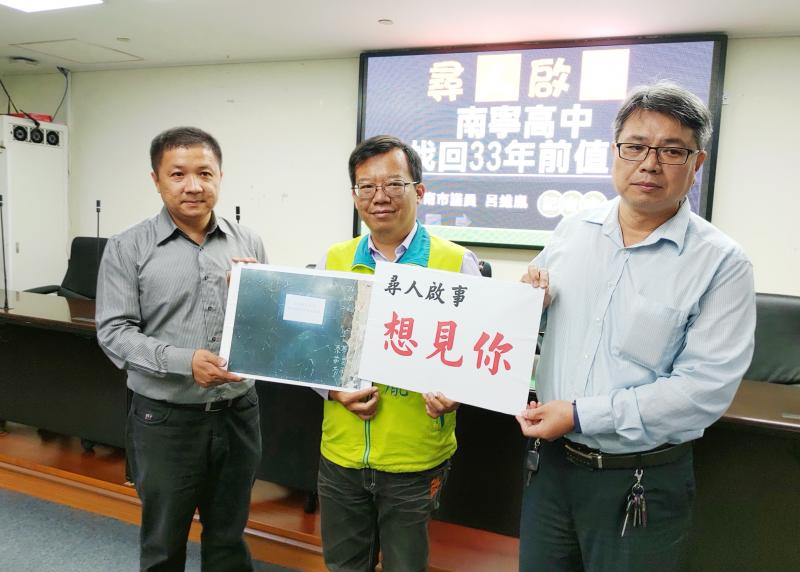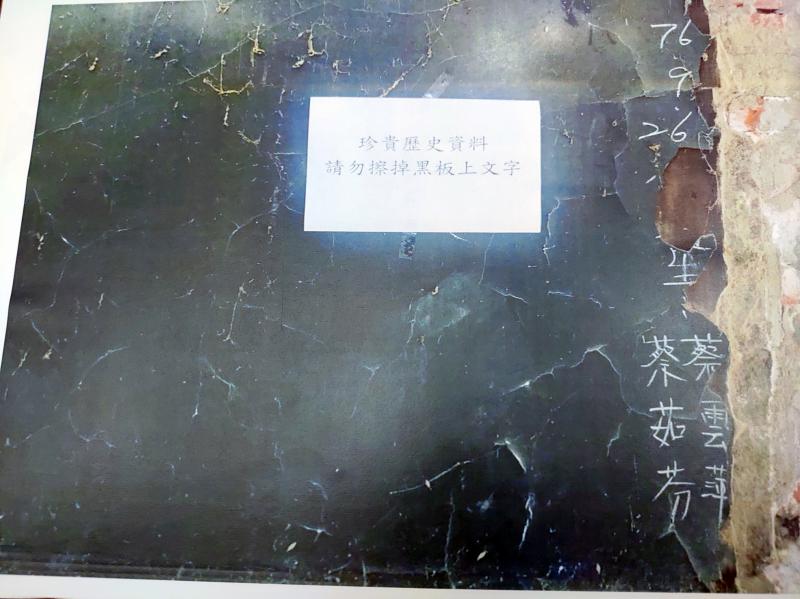Recently, during preparations to demolish an old school building, staff at Nanning High School in Tainan’s South District discovered an old piece of blackboard, on which was written the names of two sudents on duty — Tsai Yun-ping and Tsai Ju-fen — on that day, 33 years ago, in the school’s Junior High Division. On March 16, Tainan City Councilor Lu Wei-yin, school principal Su Tsung-li and Nanning parents’ association president Lin Ho-ling held a news conference with the theme “Tsai Yun-ping, Tsai Ju-fen, where are you?”, hoping to trace the owners of the two names written on the blackboard all those years ago and calling them back to their alma mater to remember the old times. That same evening the two had got in contact and said they would arrange a time to visit their old school.
According to Su, the school is currently in the process of rebuilding the school buildings, and the prodigious amounts of documents and records of students who have graduated in the past have already been packed away. The school buildings are due to be demolished at the end of the month, and so there was no time to search through the old records, and the school really wanted to find the two alumni before the month is out.
Su says that the Nanning High School was founded in 1960 as Nanning Junior High, and the Senior High School Division was established in 2003. There are several old school buildings on the campus that are over 50 years old and, because of damage sustained during the 2016 southern Taiwan earthquake, they are gradually being knocked down and rebuilt. The other day, when they were in the process of pulling down one of the old buildings, they discovered an old blackboard which still had the handwritten names of two students who were on duty on Sept. 26, 1987. This rather unusual find was quite an important historical document for the school.

Photo: Tsai Wen-chu, Liberty Times
照片:自由時報記者蔡文居
For Su, the old school buildings hold memories for all people connected to Nanning school, and at the beginning of this month they had held a series of commemorative events to mark the impending demolition of the structures, and had managed to call back almost 500 alumni for various generations to return to the alma mater and relive their memories. He hopes that should Tsai Yun-ping and Tsai Ju-fen be able to return to Nanning, they would be able to bid farewell to their old school buildings and reminisce about their school days.
After the story about their search was reported in the media, a teacher at the school, Chang Chia-ting, shared the report on his Facebook page and, with the kind help of other alumni, they had traced the two Nanning classmates, who got in contact through the Facebook pages of Lu and Chang, that same evening. Lu says that the two are both working, one in Tainan and the other in Kaohisung, and they were both expected to get in contact with the school this week, and to possibly arrange a time to visit the school on the weekend.
(Translated by Paul Cooper)

Photo: Tsai Wen-chu, Liberty Times
照片:自由時報記者蔡文居
台南市南區南寧高中日前進行舊校舍拆除作業時,意外發現舊黑板上竟留有三十三年前值日生蔡雲萍和蔡茹芬兩位國中部校友的字跡。市議員呂維胤、南寧高中校長蘇宗立和南寧家長會會長林鶴翎三月十六日在共同召開「尋人啟事」記者會,齊聲喊「雲萍、茹芬,我們想見你!」期盼能找回當年黑板上的兩名值日生,回母校重溫學生時期。當晚兩人都已經聯繫上,將安排時間重返母校。
校長蘇宗立說,因學校校舍目前正在重建,當年畢業校友相關資料非常龐大,且已完成打包,加上校舍月底就要拆除,從舊有資料去尋找緩不濟急,希望能在月底前找到兩位校友返校。
蘇宗立說,南寧高中創立於一九六○年,原為南寧國中,二○○三年成立高中部。目前校內有多棟超過五十年的舊校舍,因在二○一六大地震後受損,陸續拆除重建。日前進行舊校舍拆除作業時,發現舊黑板上竟還留存著一九八七年九月二十六日當天值日生的字跡,實屬不易,是屬於南寧的重要史料。
蘇宗立表示,舊校舍是屬於所有南寧人的回憶,三月初時更舉辦一系列舊校舍拆除紀念活動,成功喚回近五百名各世代的校友,一同重回母校,回憶當年的點點滴滴。盼望於當年擔任值日生的蔡雲萍和蔡茹芬兩位校友也能回到南寧,和充滿回憶的舊校舍告別,重溫學生時期的回憶。
尋人消息經媒體報導後,學校老師張家鼎在臉書分享本報的報導,經校友熱心協尋,兩位南寧校友於今晚分別透過市議員呂維胤的臉書和張家鼎老師的臉書連繫上。呂維胤說,兩人目前都在上班,一位在台南,另一位在高雄,本週會再和校方連繫,可能安排週六或週日重返母校。
(自由時報)

Rice is essential to Japanese culture, tradition and politics. People take pride in the oval-shaped sticky Japonica grain, which is still a staple even though total consumption has fallen over the decades. But since last summer, prices have soared as supplies have fallen short of demand. The government has long paid farmers to cut back on rice acreage, and change to other crops to keep rice prices relatively high. To cope with shortfalls this year, the government has released rice reserves. But the grain has been slow to reach supermarket shelves. Anger over that was part of the reason the Agriculture Minister

In Taiwan, 7-Eleven convenience stores can be found on almost every street corner. With over 84,600 stores across 20 countries, 7-Eleven has more locations than any other retail business on Earth. For millions of people, the chain is an important part of daily life, providing coffee, quick meals, and essential items for those __1__. The history of 7-Eleven began nearly 100 years ago in Dallas, Texas. In 1927, the Southland Ice Company began selling blocks of ice that were used to keep fridges cool. Shortly after opening, the company __2__ its offerings to include groceries like milk, eggs, and

Continued from yesterday(延續自昨日) https://www.taipeitimes.com/News/lang In 1946, the company adopted the name 7-Eleven to reflect its newly extended __3__, from 7am to 11pm, a novel concept at the time. As a rapidly growing company, it began offering franchise opportunities in the 1960s. In 1974, the first 7-Eleven in Japan was opened by the supermarket company Ito-Yokado. The Japanese franchises were __4__ successful that by 1991, Ito-Yokado was able to acquire a 70 percent stake in Southland Corporation. Its investments eventually resulted in full ownership of 7-Eleven, which paved the way for the Japanese company to enter the international market. Since then, 7-Eleven

Step into any corner of Turkiye, and you’ll likely encounter the iconic “Evil Eye,” known as “nazar boncu?u” in Turkish. This striking blue glass ornament is shaped like an eye with concentric circles of dark blue, white, and light blue. While its name in English suggests something threatening, it’s actually a charm designed to ward off misfortune. The origins of the nazar boncu?u can be traced back to ancient Mediterranean and Middle Eastern traditions. The word nazar comes from Arabic, meaning “gaze,” while boncu?u translates to “bead” in Turkish. Central to the nazar boncu?u’s mythology is the idea that